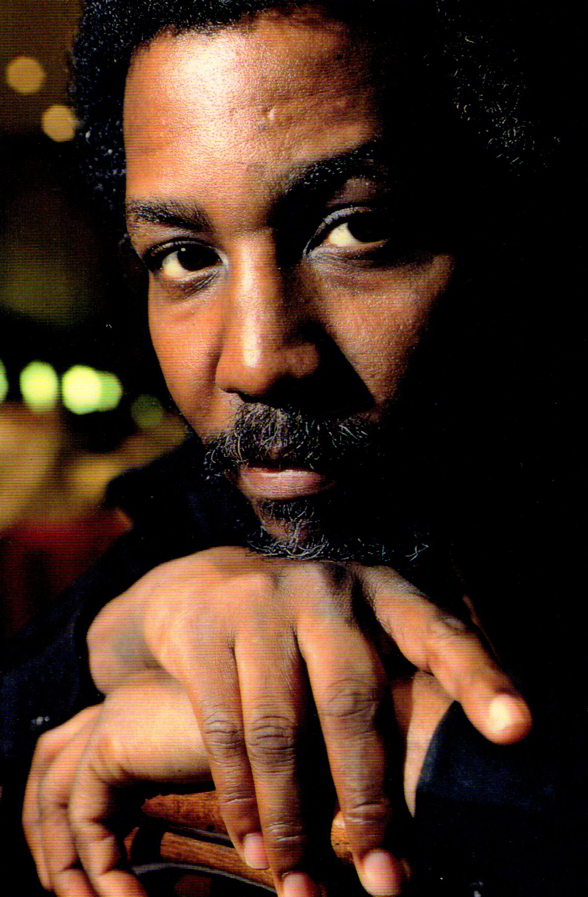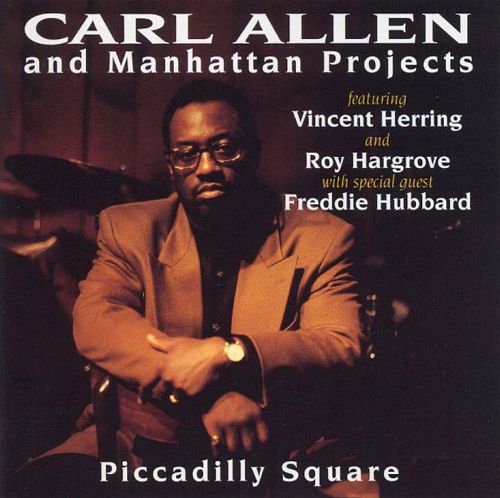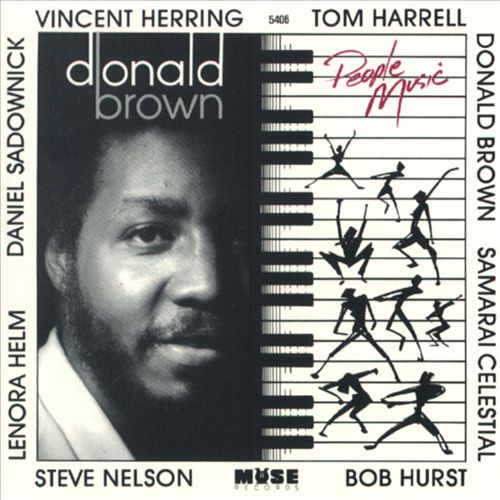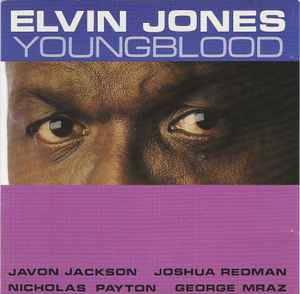Biscuit Man – Donald Brown
Combining an angular melody with over-the-barline bass figures, this song is a real workout for all instruments. It's been recorded several times, with and without Donald Brown on piano.
- Recording: Carl Allen - Piccadilly Square
- Recorded on: December 6-7, 1989
- Label: Alfa Jazz (ALCR-9)
- Concert Key: C, No key center
- Vocal Range: , to
- Style: Swing (medium up)
- Trumpet - Roy Hargrove
- Alto Sax - Vincent Herring
- Piano - Donald Brown
- Bass - Ira Coleman
- Drums - Carl Allen
Video
- Description
- Historical Notes
- Solos
- Piano Corner
- Bass Corner
- Drum Corner
- Guitar Corner
- Inside & Beyond
- Minus You
An exciting post-bop workout for melody and rhythm section alike. The 12-measure melody is full of angular structures of fourths and fifths. In the first six measures, it's complemented by off-beat bass figures (rising in half steps) in a three-beat, over-the-barline pattern. For the rest of the head, the bass mostly walks until more rhythmic figures in the last two measures. There are no chord symbols in the head—most recordings have no piano comping—but it is essentially a blues head, at least as implied in the walking part of the bass line. Solos are on blues changes in C; as there is nothing in the melody that implies a C key center, our B♭ and E♭ lead sheets have no transposed key signature (instead of showing key signatures for D and A respectively). The C treble and bass clef lead sheets show the entire bass line.
On each recording of The Biscuit Man, the rhythm section plays a bit differently. This first version has no piano comping in the head; Donald Brown doubles the melody with the horns in his right hand and the bass line in his left hand, switching to two-handed melody in octaves when the bass begins walking. Bassist Ira Coleman takes a few liberties with the walking but otherwise plays as written throughout the head. Drummer Carl Allen is mostly playing time through the bass hits at the beginning of the head; on the other recordings the drums are more active, indicated in our lead sheets as "play off bass line." The first chorus of Donald's piano solo has the same bass hits on the first six measures.
On each recording of The Biscuit Man, the rhythm section plays a bit differently. This first version has no piano comping in the head; Donald Brown doubles the melody with the horns in his right hand and the bass line in his left hand, switching to two-handed melody in octaves when the bass begins walking. Bassist Ira Coleman takes a few liberties with the walking but otherwise plays as written throughout the head. Drummer Carl Allen is mostly playing time through the bass hits at the beginning of the head; on the other recordings the drums are more active, indicated in our lead sheets as "play off bass line." The first chorus of Donald's piano solo has the same bass hits on the first six measures.
For another song from this album check out Roy Hargrove's A New Joy. Roy Hargrove's only recordings with Donald Brown were "Piccadilly Square" and "Dreamboat," the debut album of Carl Allen's Manhattan Projects quintet recorded earlier in 1989. Allen played on the only other recording with Hargrove and Vincent Herring in a quintet setting, a version of Hank Mobley's Soft Impressions from Herring's 1997 album "Change The World."
Related Songs
Email Send Biscuit Man to a friend
Send this page to a friend via email. Add your name or email in the first field. In the second, add one or more email addresses, separated by a comma.
- Recording: Donald Brown - People Music
- Recorded on: March 19 & 21, 1990
- Label: Muse (MCD 5406)
- Concert Key: C, No key center
- Vocal Range: , to
- Style: Swing (uptempo)
- Trumpet - Tom Harrell
- Soprano Sax - Vincent Herring
- Vibes - Steve Nelson
- Piano - Donald Brown
- Bass - Robert Hurst
- Drums - Eric Walker
Video
- Description
- Historical Notes
- Solos
- Piano Corner
- Bass Corner
- Drum Corner
- Guitar Corner
- Inside & Beyond
- Minus You
Donald Brown's own version is rather faster than the original recording. Donald again doubles both the melody and bass hits; on the first time through the in head, he adds a little left-hand comping, implying a D7-G7 turnaround in the ninth and tenth measures. Drummer Eric Walker really plays off the bass hits in the first six measures; bassist Robert Hurst interprets the last six measures a bit more loosely. The bass hits are also played in the first chorus of Tom Harrell's trumpet solo.
As mentioned in the liner notes of "People Music," Donald Brown dedicates this song to bassist Charles Fambrough, with whom he played in Art Blakey's Jazz Messengers.
Vibraphonist Steve Nelson first recorded with Donald Brown on the latter's debut album as a leader, "Early Bird" in 1987. They have played together on seven of Brown's albums so far as well as Nelson's "Live Session One."
Vibraphonist Steve Nelson first recorded with Donald Brown on the latter's debut album as a leader, "Early Bird" in 1987. They have played together on seven of Brown's albums so far as well as Nelson's "Live Session One."
Related Songs
Email Send Biscuit Man to a friend
Send this page to a friend via email. Add your name or email in the first field. In the second, add one or more email addresses, separated by a comma.
- Recording: Elvin Jones - Youngblood
- Recorded on: April 20-21, 1992
- Label: Enja (ENJ 7051)
- Concert Key: C, No key center
- Vocal Range: , to
- Style: Swing (medium up)
- Trumpet - Nicholas Payton
- Tenor Sax - Javon Jackson & Joshua Redman
- Bass - George Mraz
- Drums - Elvin Jones
Video
- Description
- Historical Notes
- Solos
- Piano Corner
- Bass Corner
- Drum Corner
- Guitar Corner
- Inside & Beyond
- Minus You
This chordless quintet recording by drummer Elvin Jones is around the same tempo as the original version, recorded by Carl Allen. Bassist George Mraz plays the line exactly as written, while on both in and out heads Elvin plays mostly time on the first chorus, playing a bit more off the bass hits on the repeat. Unlike the other recordings, the bass hits never return in the solos.
"Youngblood" was Elvin Jones' second to last session as a leader at Van Gelder Studio. Later in 1992, he was back at Van Gelder to record "Going Home," also featuring trumpeter Nicholas Payton.
In 2001, Bill Mobley recorded a big band arrangement of The Biscuit Man on his album "New Light." Another version of this song was recorded by pianist Keith Brown, Donald Brown's son, in 2015 for his album "The Journey." This trio version is quite experimental, a completely reharmonized, mixed-meter arrangement that preserves only the first 10 measures of the melody before going into an even-8ths 7/4 vamp with a D major tonality—even though the melody is not transposed.
In 2001, Bill Mobley recorded a big band arrangement of The Biscuit Man on his album "New Light." Another version of this song was recorded by pianist Keith Brown, Donald Brown's son, in 2015 for his album "The Journey." This trio version is quite experimental, a completely reharmonized, mixed-meter arrangement that preserves only the first 10 measures of the melody before going into an even-8ths 7/4 vamp with a D major tonality—even though the melody is not transposed.
Related Songs
Email Send Biscuit Man to a friend
Send this page to a friend via email. Add your name or email in the first field. In the second, add one or more email addresses, separated by a comma.

Donald Brown
born on March 28, 1954
A lyrical pianist and prolific composer as well as a teacher, band leader and arranger, Donald Brown is considered one of the masters of contemporary jazz composition. Raised in Memphis, Tennessee, Donald studied trumpet and drums as a youth. It was not until he began studying at Memphis State University that he switched to piano as his primary instrument, the late start making his pianistic skill all the more incredible. Read more...
There was a problem.
...



